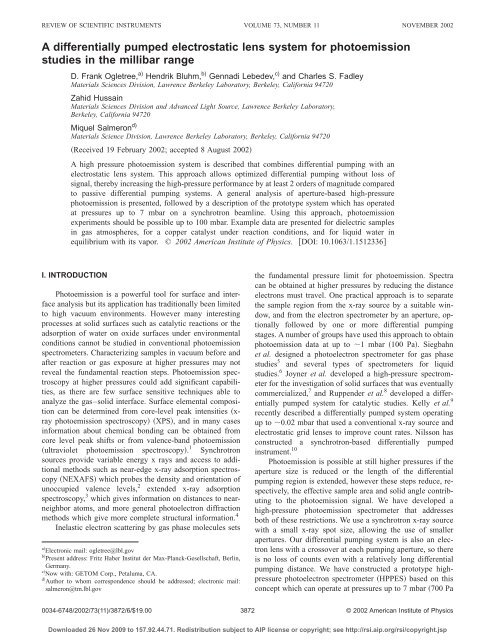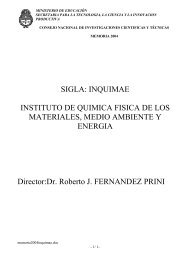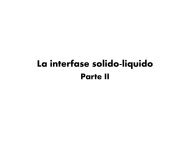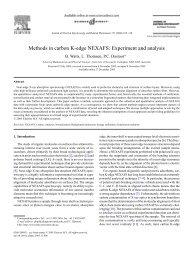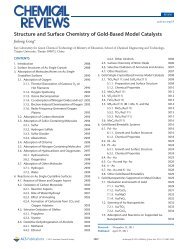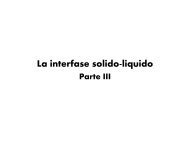A differentially pumped electrostatic lens system for ... - inquimae
A differentially pumped electrostatic lens system for ... - inquimae
A differentially pumped electrostatic lens system for ... - inquimae
Create successful ePaper yourself
Turn your PDF publications into a flip-book with our unique Google optimized e-Paper software.
REVIEW OF SCIENTIFIC INSTRUMENTS VOLUME 73, NUMBER 11 NOVEMBER 2002<br />
A <strong>differentially</strong> <strong>pumped</strong> <strong>electrostatic</strong> <strong>lens</strong> <strong>system</strong> <strong>for</strong> photoemission<br />
studies in the millibar range<br />
D. Frank Ogletree, a) Hendrik Bluhm, b) Gennadi Lebedev, c) and Charles S. Fadley<br />
Materials Sciences Division, Lawrence Berkeley Laboratory, Berkeley, Cali<strong>for</strong>nia 94720<br />
Zahid Hussain<br />
Materials Sciences Division and Advanced Light Source, Lawrence Berkeley Laboratory,<br />
Berkeley, Cali<strong>for</strong>nia 94720<br />
Miquel Salmeron d)<br />
Materials Science Division, Lawrence Berkeley Laboratory, Berkeley, Cali<strong>for</strong>nia 94720<br />
Received 19 February 2002; accepted 8 August 2002<br />
A high pressure photoemission <strong>system</strong> is described that combines differential pumping with an<br />
<strong>electrostatic</strong> <strong>lens</strong> <strong>system</strong>. This approach allows optimized differential pumping without loss of<br />
signal, thereby increasing the high-pressure per<strong>for</strong>mance by at least 2 orders of magnitude compared<br />
to passive differential pumping <strong>system</strong>s. A general analysis of aperture-based high-pressure<br />
photoemission is presented, followed by a description of the prototype <strong>system</strong> which has operated<br />
at pressures up to 7 mbar on a synchrotron beamline. Using this approach, photoemission<br />
experiments should be possible up to 100 mbar. Example data are presented <strong>for</strong> dielectric samples<br />
in gas atmospheres, <strong>for</strong> a copper catalyst under reaction conditions, and <strong>for</strong> liquid water in<br />
equilibrium with its vapor. © 2002 American Institute of Physics. DOI: 10.1063/1.1512336<br />
I. INTRODUCTION<br />
Photoemission is a powerful tool <strong>for</strong> surface and interface<br />
analysis but its application has traditionally been limited<br />
to high vacuum environments. However many interesting<br />
processes at solid surfaces such as catalytic reactions or the<br />
adsorption of water on oxide surfaces under environmental<br />
conditions cannot be studied in conventional photoemission<br />
spectrometers. Characterizing samples in vacuum be<strong>for</strong>e and<br />
after reaction or gas exposure at higher pressures may not<br />
reveal the fundamental reaction steps. Photoemission spectroscopy<br />
at higher pressures could add significant capabilities,<br />
as there are few surface sensitive techniques able to<br />
analyze the gas–solid interface. Surface elemental composition<br />
can be determined from core-level peak intensities xray<br />
photoemission spectroscopy XPS, and in many cases<br />
in<strong>for</strong>mation about chemical bonding can be obtained from<br />
core level peak shifts or from valence-band photoemission<br />
ultraviolet photoemission spectroscopy. 1 Synchrotron<br />
sources provide variable energy x rays and access to additional<br />
methods such as near-edge x-ray adsorption spectroscopy<br />
NEXAFS which probes the density and orientation of<br />
unoccupied valence levels, 2 extended x-ray adsorption<br />
spectroscopy, 3 which gives in<strong>for</strong>mation on distances to nearneighbor<br />
atoms, and more general photoelectron diffraction<br />
methods which give more complete structural in<strong>for</strong>mation. 4<br />
Inelastic electron scattering by gas phase molecules sets<br />
a Electronic mail: ogletree@lbl.gov<br />
b Present address: Fritz Haber Institut der Max-Planck-Gesellschaft, Berlin,<br />
Germany.<br />
c Now with: GETOM Corp., Petaluma, CA.<br />
d Author to whom correspondence should be addressed; electronic mail:<br />
salmeron@tm.lbl.gov<br />
the fundamental pressure limit <strong>for</strong> photoemission. Spectra<br />
can be obtained at higher pressures by reducing the distance<br />
electrons must travel. One practical approach is to separate<br />
the sample region from the x-ray source by a suitable window,<br />
and from the electron spectrometer by an aperture, optionally<br />
followed by one or more differential pumping<br />
stages. A number of groups have used this approach to obtain<br />
photoemission data at up to 1 mbar 100 Pa. Siegbahn<br />
et al. designed a photoelectron spectrometer <strong>for</strong> gas phase<br />
studies 5 and several types of spectrometers <strong>for</strong> liquid<br />
studies. 6 Joyner et al. developed a high-pressure spectrometer<br />
<strong>for</strong> the investigation of solid surfaces that was eventually<br />
commercialized, 7 and Ruppender et al. 8 developed a <strong>differentially</strong><br />
<strong>pumped</strong> <strong>system</strong> <strong>for</strong> catalytic studies. Kelly et al. 9<br />
recently described a <strong>differentially</strong> <strong>pumped</strong> <strong>system</strong> operating<br />
up to 0.02 mbar that used a conventional x-ray source and<br />
<strong>electrostatic</strong> grid <strong>lens</strong>es to improve count rates. Nilsson has<br />
constructed a synchrotron-based <strong>differentially</strong> <strong>pumped</strong><br />
instrument. 10<br />
Photoemission is possible at still higher pressures if the<br />
aperture size is reduced or the length of the differential<br />
pumping region is extended, however these steps reduce, respectively,<br />
the effective sample area and solid angle contributing<br />
to the photoemission signal. We have developed a<br />
high-pressure photoemission spectrometer that addresses<br />
both of these restrictions. We use a synchrotron x-ray source<br />
with a small x-ray spot size, allowing the use of smaller<br />
apertures. Our differential pumping <strong>system</strong> is also an electron<br />
<strong>lens</strong> with a crossover at each pumping aperture, so there<br />
is no loss of counts even with a relatively long differential<br />
pumping distance. We have constructed a prototype highpressure<br />
photoelectron spectrometer HPPES based on this<br />
concept which can operate at pressures up to 7 mbar 700 Pa<br />
0034-6748/2002/73(11)/3872/6/$19.00 3872<br />
© 2002 American Institute of Physics<br />
Downloaded 26 Nov 2009 to 157.92.44.71. Redistribution subject to AIP license or copyright; see http://rsi.aip.org/rsi/copyright.jsp
Rev. Sci. Instrum., Vol. 73, No. 11, November 2002<br />
A <strong>differentially</strong> <strong>pumped</strong> <strong>electrostatic</strong> <strong>lens</strong><br />
3873<br />
or 5 Torr. This <strong>system</strong> has been used to study the premelting<br />
of ice in equilibrium with water vapor 11 and the partial<br />
oxidation of methanol over copper under reaction<br />
conditions. 12 As an additional benefit we find that surface<br />
charging of insulating samples is compensated by impinging<br />
gas phase ions generated by the x rays at pressures above<br />
0.5 mbar. We are now developing a second-generation<br />
HPPES with more flexible sample preparation that should be<br />
able to operate at up to 100 mbar.<br />
We will now give a general analysis of high-pressure<br />
photoemission followed by a description of our prototype<br />
<strong>system</strong> and some examples of experimental data.<br />
II. HIGH-PRESSURE PHOTOEMISSION AND<br />
DIFFERENTIAL PUMPING<br />
We will first analyze the aperture-based HPPES using<br />
simple ideal gas theory <strong>for</strong> molecular flow conditions. 13 This<br />
will be followed by some comments on the limits of this<br />
approximation. An aperture of radius R separates a region of<br />
gas pressure P o from another region at much lower pressure.<br />
We consider an electron traveling along the axis perpendicular<br />
to the aperture at position z. Ifz is measured in units of R<br />
and the origin is in the plane of the aperture with positive z<br />
on the vacuum side, the aperture subtends an angle (z)<br />
arccos(z/1z 2 ). The effective pressure is proportional<br />
to the included solid angle of the high-pressure region so<br />
P(z) 1 2 P o (1z/1z 2 ).<br />
If the sample is placed close to the aperture, the pressure<br />
at the sample surface will be less than P o , but the effect of<br />
the aperture drops off rather quickly. At a distance of 2R<br />
the pressure is already 95% of P o , while at 2R it is only<br />
5%. Most of the electron attenuation takes place close to the<br />
aperture. To calculate electron attenuation where gas pressure<br />
is a function of position we can define an effective path<br />
length through the gas as L (1/P o ) P(x)dx. Using the<br />
expression <strong>for</strong> P(z) above, the effective path length <strong>for</strong> a<br />
trajectory starting at z and extended far into the vacuum region<br />
is L(z) 1 2 R(1z 2 z). For a sample at 2R, the<br />
effective path length is 2.1R while <strong>for</strong> a sample at the aperture<br />
plane it is 0.5R. In the same way, it can be seen that 88%<br />
of the effective path and thus of the attenuation after the<br />
aperture takes place within 4R, assuming ideal pumping.<br />
There<strong>for</strong>e, there is little to be gained by schemes to separate<br />
the electron trajectory from the gas jet exiting the aperture.<br />
The electron mean free path is 4kT/P, where the<br />
electron scattering cross section depends on the electron<br />
energy and gas composition. The density of a gas at 1 mbar<br />
and 293 K is about 10 6 smaller than <strong>for</strong> a condensed solid, so<br />
the mean free path <strong>for</strong> low energy electrons will increase<br />
from nm in a solid to mm in a gas at 1 mbar. The mean<br />
free path also increases approximately proportional to the<br />
square root of electron kinetic energy. 14 If the sample is<br />
placed a distance 2R from the aperture, and the effective<br />
path length is limited to 2, then P max 4kT/R. Our prototype<br />
HPPES <strong>system</strong> had R0.45 mm and <strong>for</strong> O KLL electrons<br />
at 500 eV the mean free path was 3 mm at 1 mbar, which<br />
gave P max 7 mbar. P max can be increased by reducing the<br />
aperture size, and with a synchrotron light source it should<br />
be possible to reduce the x-ray spot size and the aperture to<br />
25 m to obtain P max 100 mbar.<br />
The volumetric conductance of an aperture S A<br />
(/4) R 2 v¯R 2 kT/2M, where v¯ is the average molecular<br />
velocity and M is the molecular mass. The pressure P 1<br />
outside the aperture is determined by the effective pumping<br />
speed S 1 <strong>for</strong> the vacuum <strong>system</strong> so P 1 /P o S A /S 1 . In a<br />
typical vacuum <strong>system</strong> it is difficult to get a conductancelimited<br />
pumping speed greater than 100 l/s 0.1 m 3 /s.<br />
With S A 0.1 l/s <strong>for</strong> water vapor at 293 K and R0.45 mm it<br />
follows that <strong>for</strong> a single pumping stage P 1 /P o 10 3 .<br />
The electron spectrometer should ideally be kept at a<br />
pressure in the 10 7 mbar range to protect the electron multiplier,<br />
so <strong>for</strong> operation with P o 10 mbar two additional<br />
stages of differential pumping are required to obtain a pressure<br />
differential P o /P 3 10 8 . This puts certain constraints<br />
on the dimensions of a <strong>differentially</strong> <strong>pumped</strong> <strong>system</strong>. The<br />
gas flux through the first aperture is P o S A . Even with ideal<br />
pumping of the scattered gas molecules, a fraction (1/) <br />
of the flux will pass through the differential pumping <strong>system</strong><br />
as a molecular beam, where is the solid angle of the<br />
differential pumping exit aperture seen from the source aperture.<br />
This gives a minimum length L <strong>for</strong> the differential<br />
pumping <strong>system</strong><br />
LR 3 S A<br />
S 3<br />
P o<br />
P 3<br />
,<br />
where S 3 and P 3 are the pumping speed and pressure in the<br />
final stage and R 3 the radius of the exit aperture. With a<br />
pressure ratio of 10 8 and a conductance ratio of 10 3 , as<br />
above, this gives L300R 3 .<br />
The preceding analysis in terms of molecular flow is<br />
appropriate if the mean free path <strong>for</strong> gas molecule–molecule<br />
interactions is large compared to the aperture size. On the<br />
other hand, if the aperture is large compared to the mean free<br />
path then the gas jet is best described as a supersonic molecular<br />
beam. The gas mean free path is given by gas<br />
kT/2P gas , where the collision cross section is approximately<br />
the geometrical size of the molecule, so <strong>for</strong> water<br />
vapor at 1 mbar the mean free path is 0.4 mm. At the<br />
maximum pressure of 7 mbar <strong>for</strong> 500 eV electrons, the<br />
effective path length of 2.1R is about 30 times gas . Neither<br />
the molecular nor the viscous flow limits are really appropriate<br />
in this case of intermediate, or Knudsen flow, and a detailed<br />
analysis would require numerical simulations. The supersonic<br />
viscous flow case can be analyzed analytically, 15<br />
however, and the results are not very different than <strong>for</strong> the<br />
molecular flow case. The results now depend on the internal<br />
degrees of freedom of the gas molecule and differ <strong>for</strong> atomic,<br />
diatomic and polyatomic molecules. The total flux through<br />
the aperture increases by 1.6 and the flux is more directional,<br />
so the relative density along the aperture axis is increased<br />
by 2.0 <strong>for</strong> atomic, 1.4 <strong>for</strong> diatomic, or 1.1 <strong>for</strong> polyatomic<br />
species. The pressure in the aperture plane is 0.63P o ,<br />
compared to 0.5 <strong>for</strong> molecular flow. The effective attenuation<br />
after the aperture plane can be calculated <strong>for</strong> the water case,<br />
and is 1.03R, compared to 0.5R <strong>for</strong> the molecular flow case.<br />
Downloaded 26 Nov 2009 to 157.92.44.71. Redistribution subject to AIP license or copyright; see http://rsi.aip.org/rsi/copyright.jsp
3874 Rev. Sci. Instrum., Vol. 73, No. 11, November 2002 Ogletree et al.<br />
The pressure distribution in the sample region is more complex,<br />
and will depend on its detailed geometry. None of these<br />
factors change the general conclusions reached above, it is<br />
just that the molecular flow analysis tends to underestimate<br />
the attenuation and gas flow at higher pressures, but not by<br />
worse than a factor of 2.<br />
III. HIGH PRESSURE PHOTOEMISSION AND<br />
ELECTRON OPTICS<br />
While reducing the transmitted solid angle improves the<br />
differential pumping by reducing the gas flux, it also reduces<br />
the electron flux. A typical hemispherical analyzer input <strong>lens</strong><br />
can accept a half angle of up to <strong>lens</strong> 1/8 or 125 mrad<br />
8°. 16 Operation with a high source pressure requires a<br />
differential pumping <strong>system</strong> that is long compared to the<br />
aperture diameters, which results in a relatively small transmitted<br />
solid angle, only diff 1/3003.3 mrad 0.2° in<br />
the case described above. This will reduce the photoemission<br />
by a factor of ( <strong>lens</strong> / diff ) 2 or more than 3 orders of magnitude<br />
compared to a vacuum analyzer. In our new HPPES we<br />
have constructed a differential pumping <strong>system</strong> that is also<br />
an electron <strong>lens</strong> <strong>system</strong> with crossovers in the aperture<br />
planes. With this approach we are free to optimize the pumping<br />
<strong>system</strong>, while still collecting most of the electrons which<br />
pass unscattered through the first aperture, thereby increasing<br />
the high-pressure signal by at least 2 orders of magnitude<br />
compared to a passive differential pumping <strong>system</strong>.<br />
IV. THE HPPES PROTOTYPE<br />
A prototype <strong>system</strong> was developed to validate our<br />
HPPES concept using an existing surface science vacuum<br />
chamber at beamline 9.3.2 of the LBNL Advanced light<br />
source. The two-stage <strong>lens</strong> <strong>system</strong> and a closed sample cell<br />
fed by gas lines was mounted on an 8 in. flange of the<br />
vacuum chamber, and a standard hemispherical analyzer was<br />
mounted on the <strong>lens</strong> <strong>system</strong>, as shown in Fig. 1. Primary<br />
pumping was provided through the vacuum chamber, second<br />
stage pumping through the <strong>lens</strong>, and the final pumping<br />
through the hemispherical analyzer 17 pumping port, using<br />
three 250 l/s turbo pumps. 18 Gases were supplied through<br />
mass-flow controllers except <strong>for</strong> water vapor, which was supplied<br />
by a pressure-controlled choked flow through an aperture,<br />
and cell pressure was monitored with a capacitance<br />
manometer. 19<br />
The first aperture or ‘‘nozzle’’ had an aperture diameter<br />
of 0.9 mm and the sample–nozzle distance was variable. The<br />
first <strong>lens</strong> stage was 33 mm long and 6 mm in diameter with<br />
a 1.5 mm exit aperture, and the second stage was 145 mm<br />
long and 20 mm in diameter with a3mmexit aperture. The<br />
final <strong>lens</strong> focus was 4 mm beyond the exit aperture and in the<br />
focal plane of the hemispherical analyzer, 18 mm in front of<br />
its input <strong>lens</strong>. It was possible to maintain a pressure difference<br />
of 10 8 between the sample cell and an ion gauge at the<br />
analyzer pumping port. With a 0.9 mm aperture the maximum<br />
cell pressure was limited to 7 mbar by the throughput<br />
of the first stage turbo pump.<br />
The electron optic <strong>system</strong> consisted of five independently<br />
controlled <strong>lens</strong>es, plus the exit aperture, which was<br />
FIG. 1. Schematic drawing of the prototype HPPES <strong>system</strong>. The upper<br />
section shows a detail of the first <strong>lens</strong> and sample region. The photon beam<br />
enters the high-pressure sample cell through an Al window of typically 100<br />
nm thickness. Electrons and a gas jet pass through the apertures of the <strong>lens</strong><br />
<strong>system</strong>. The sample holder pictured here was the type used <strong>for</strong> water/ice<br />
studies. The lower section shows the complete <strong>system</strong> and the hemispherical<br />
analyzer input <strong>lens</strong> hatched entering the main 8 in. vacuum flange. The<br />
high-pressure cell volume is one liter. The <strong>lens</strong> elements solid black are<br />
numbered: 1 nozzle, 2 control, 3 skimmer, 4 condenser, 5 quadrupole,<br />
and 6 exit aperture. Elements 1–3 comprise the first <strong>lens</strong>/pumping<br />
stage and elements 3–6 the second <strong>lens</strong>/pumping stage.<br />
always grounded. In practice we also grounded the sample<br />
and the entrance nozzle. We refer to the other <strong>lens</strong> elements<br />
along the electron trajectory as the control, skimmer, condenser,<br />
and quadrupole <strong>lens</strong>es. The <strong>lens</strong> voltages were programmable<br />
with 5 kV supplies <strong>for</strong> the control and condenser<br />
<strong>lens</strong>es, 1 kV <strong>for</strong> the skimmer, and 3 kV <strong>for</strong> the<br />
condenser. The quadrupole <strong>lens</strong> was split in four sections <strong>for</strong><br />
deflection control but no use was made of this capability<br />
since the hemispherical analyzer input <strong>lens</strong> was also<br />
equipped with deflection plates, which were dynamically adjusted<br />
as a function of electron kinetic energy. This was done<br />
to compensate <strong>for</strong> misalignment of the analyzer and also <strong>for</strong><br />
magnetic field effects as the prototype <strong>system</strong> had no magnetic<br />
shielding. The HPPES <strong>lens</strong>es and the hemispherical<br />
analyzer, including deflection plates and counting electronics,<br />
were software controlled from a PC running LABVIEW. 20<br />
The nozzle, control, and skimmer electrodes <strong>for</strong>med a<br />
three-element <strong>lens</strong> to focus electrons onto the intermediate<br />
aperture, and the skimmer, condenser and quadrupole <strong>for</strong>med<br />
a four-element <strong>lens</strong>, along with the exit aperture, to refocus<br />
the electrons in the hemispherical analyzer sample plane.<br />
The <strong>lens</strong> <strong>system</strong> was operated <strong>for</strong> electron kinetic energies<br />
from 50 to 1000 eV. Per<strong>for</strong>mance was poor below 50 eV,<br />
Downloaded 26 Nov 2009 to 157.92.44.71. Redistribution subject to AIP license or copyright; see http://rsi.aip.org/rsi/copyright.jsp
Rev. Sci. Instrum., Vol. 73, No. 11, November 2002<br />
A <strong>differentially</strong> <strong>pumped</strong> <strong>electrostatic</strong> <strong>lens</strong><br />
3875<br />
probably due to the lack of magnetic shielding. Optimum<br />
transmission <strong>for</strong> the first <strong>lens</strong> was obtained with an acceleration<br />
of 34:1 between nozzle and control electrode, followed<br />
by a deceleration of 20:1 between control and skimmer.<br />
Above 150 eV the available power supplies could no<br />
longer maintain the optimum acceleration ratio, and it was<br />
not possible to maintain a focus at the intermediate aperture.<br />
The best transmission was obtained with the control electrode<br />
set at 5 kV and the skimmer adjusted to maintain<br />
close to a 20:1 deceleration. In the second stage the best<br />
transmission was obtained with the condenser at 5 kV, <strong>for</strong><br />
an acceleration around 20:1, followed by deceleration to the<br />
initial electron kinetic energy in two unequal steps, with the<br />
deceleration ratio twice as high from the condenser to the<br />
quadrupole as from the quadrupole to the exit aperture.<br />
Better per<strong>for</strong>mance could have been obtained with a<br />
longer, multielement <strong>lens</strong> <strong>for</strong> the first stage, and this is<br />
planned <strong>for</strong> the second generation HPPES <strong>system</strong>. Also, the<br />
<strong>lens</strong> voltages are constrained in the first stage during highpressure<br />
operation by the need to avoid exciting a dc plasma<br />
discharge. For water vapor, 4 mbar was the maximum cell<br />
pressure with the control electrode at 5 kV. At 7 mbar the<br />
control electrode voltage could not exceed 1.5 kV. A multielement<br />
<strong>lens</strong> will also add flexibility <strong>for</strong> lower voltage operation.<br />
The main vacuum chamber was separated from the<br />
beamline and from the sample cell by a pair of 100 nm Al<br />
windows, and the 1 mm diam x-ray beam was incident on<br />
the sample 75° from the sample normal, which was aligned<br />
along the HPPES axis. The x-ray path length in the high<br />
pressure cell was approximately 20 mm. Using a graphite<br />
test sample with a 600 line/mm grating in the beamline<br />
monochromator at 1/1000 energy resolution and 450 eV photon<br />
energy, we could measure a sample photocurrent of 2<br />
nA <strong>for</strong> a grounded sample. With no gas in the cell we could<br />
obtain a count rate 400 kHz from the C 1s line at 1 eV<br />
analyzer resolution. These conditions correspond to maximum<br />
transmission <strong>for</strong> both the beamline and the HPPES<br />
<strong>lens</strong>. The count rate was inversely proportional to both photon<br />
and electron energy resolution, as expected. Figure 2<br />
shows a series of survey spectra <strong>for</strong> a Rh111 sample at<br />
various photon energies. The ‘‘bump’’ between 75 and 175<br />
eV kinetic energies is due to the change in <strong>lens</strong> operating<br />
modes. Aside from this feature, the <strong>lens</strong> transmission is relatively<br />
uni<strong>for</strong>m.<br />
V. RESULTS<br />
A. Insulating materials<br />
To demonstrate the per<strong>for</strong>mance of our instrument we<br />
present three examples of applications in the areas of catalysis<br />
and environmental sciences. Figure 3 shows an XPS survey<br />
spectrum of a KCl001 surface in an atmosphere of 0.7<br />
mbar of water vapor at room temperature. The sample was<br />
prepared ex situ by cleavage. The spectrum in Fig. 3 shows<br />
photoemission and Auger peaks from the surface K, Cl, C<br />
and the O 1s and O KLL lines from the water gas phase.<br />
When the KCl sample was measured in vacuum, we observed<br />
surface charging on the order of several hundred V.<br />
FIG. 2. A series of HPPES spectra from a Rh111 sample in vacuum as the<br />
incident photon energy was reduced from 800 to 200 eV in 50 eV steps.<br />
Photoemission peaks shift by 50 eV to lower kinetic energy in successive<br />
spectra while Auger peaks are unchanged. The HPPES transmission varies<br />
smoothly with kinetic energy except <strong>for</strong> the ‘‘bump’’ between 75 and 160<br />
eV. The peaks near 500 eV in the lower spectra are Rh 3d 3/2,5/2 and C 1s.<br />
Note how the relative intensities change with photon energy due to changes<br />
in absorption cross sections and electron mean free path. At lower photon<br />
energies contributions due to the beamline monochromator second, third,<br />
and even fourth harmonics can be seen. Count rates are <strong>for</strong> maximum hemisphere<br />
pass energy resolution 1.6 eV, normalized by the beamline flux<br />
monitor photocurrent up to 300 pA at 450 eV, E/E 0.1%, but not<br />
corrected <strong>for</strong> the attenuation of two 100 nm thick Al x-ray windows.<br />
The spectra recorded in 0.7 mbar water vapor, however, did<br />
not show any shifts in the photoelectron or Auger peak positions.<br />
Surface charging of insulating samples was compensated<br />
by gas phase ionization due to the incident x rays. A<br />
similar effect was observed in argon. Insulating samples can<br />
thus be studied without the need <strong>for</strong> a flood gun.<br />
B. Catalytic studies<br />
In catalytic studies it is crucial to determine the state of<br />
the surface of the catalyst while exposed to reactant gases<br />
Downloaded 26 Nov 2009 to 157.92.44.71. Redistribution subject to AIP license or copyright; see http://rsi.aip.org/rsi/copyright.jsp
3876 Rev. Sci. Instrum., Vol. 73, No. 11, November 2002 Ogletree et al.<br />
FIG. 3. XPS spectrum of a KCl 100 sample in 0.7 mbar water vapor. The<br />
incident photon energy was 650 eV. Photoemission and Auger lines from the<br />
surface K, Cl, and C as well as oxygen O 1s and O KLL lines from the gas<br />
phase are present in the spectrum. The charging of the insulating KCl<br />
sample is compensated by ions generated in the gas phase. When the same<br />
spectrum was acquired in vacuum, the peaks were strongly shifted due to<br />
charging.<br />
and products. The first HPPES catalytic study investigated<br />
the partial oxidation of methanol to <strong>for</strong>maldehyde over copper<br />
in the presence of oxygen. Figure 4 shows the O 1s region<br />
of an XPS spectrum of a polycrystalline Cu foil sample<br />
in 0.7 mbar of O 2 at 400 °C. The O 1s Cu 2 O peak is found at<br />
530.2 eV, in agreement with literature values. 21 The lower<br />
binding energy shoulder at 529.1 eV is probably due to small<br />
amounts of CuO <strong>for</strong>med during the oxidation of the Cu foil.<br />
Gas phase species are visible in the spectrum along with<br />
surface species. In most cases molecular XPS peaks are significantly<br />
shifted from those of chemisorbed species. The gas<br />
phase peaks give in<strong>for</strong>mation on the reactant and product<br />
distributions near the sample surface. In the present example<br />
the O 1s peak of gas phase O 2 is split due to the paramagnetic<br />
nature of the O 2 molecule. 22 These peaks, at 538.3 and<br />
539.4 eV, are shifted by 4.8 eV toward lower binding energy<br />
compared to the literature values 5 since our binding energy<br />
FIG. 4. An XPS spectrum O1s region of a Cu foil in the presence of 0.7<br />
mbar O 2 at 400 °C. The incident photon energy was 600 eV. The peak at<br />
530.2 eV originates from Cu 2 O, <strong>for</strong>med at the surface under the oxidizing<br />
conditions. In addition, some CuO is <strong>for</strong>med at the surface and gives rise to<br />
the smaller peak at 529.1 eV. The O 2 gas phase peak is split into two due to<br />
the paramagnetic nature of the O 2 molecule.<br />
FIG. 5. Auger yield near-edge x-ray absorption spectrum of a supercooled<br />
water drop 2.5 °C in equilibrium with its vapor 5 mbar. The water drop<br />
diameter 3 mm was grown from the vapor onto a temperature-controlled<br />
Cu sample holder. The hemispherical analyzer was used as a partial yield<br />
electron detector to collect electrons from the surface with kinetic energies<br />
between 413 and 437 eV. The first peak in the spectrum at 535 eV is highly<br />
sensitive to the local hydrogen bonding structure of the water molecules and<br />
was used to investigate the premelting of ice.<br />
scale is related to the copper Fermi level rather than the<br />
vacuum level.<br />
C. Environmental studies: Water in equilibrium with<br />
its vapor<br />
We have used our HPPES setup to carry out NEXAFS<br />
experiments on ice and liquid water in equilibrium with water<br />
vapor the vapor pressure is close to 6 mbar at the triple<br />
point. Figure 5 shows an Auger yield NEXAFS spectrum<br />
from the surface of a supercooled water drop. The droplet<br />
was condensed from the vapor onto a cooled Cu sample<br />
holder. The temperature of the water drop was 2.5 °C in 5<br />
mbar of water vapor, i.e., the water drop was in equilibrium<br />
with its vapor. Total electron yield NEXAFS data are hard to<br />
interpret in high vapor pressure experiments due to gas phase<br />
ionization and inelastic ionization cascades. The HPPES allowed<br />
us to make energy resolved measurements of the O KLL<br />
Auger yield from the ice/water surface. Only those gas molecules<br />
that were ionized in front of the <strong>lens</strong> aperture contributed<br />
to the HPPES signal. The surface NEXAFS spectrum<br />
was recorded by collecting electrons with kinetic energies in<br />
the range from 413 to 437 eV. This range was chosen to<br />
maximize the signal from the condensed phase relative to the<br />
gas phase. The most salient feature of the spectrum of Fig. 5<br />
is the first peak at 535 eV. This peak is highly sensitive to the<br />
local hydrogen bonding structure of the water molecules 23<br />
and exhibits appreciable changes when water freezes and becomes<br />
crystalline. We have recently completed a HPPES<br />
NEXAFS study the premelting of ice as detailed in Ref. 11.<br />
VI. FURTHER DEVELOPMENT<br />
We have developed a high-pressure photoelectron spectrometer<br />
that combines differential pumping and <strong>electrostatic</strong><br />
focusing of the photoelectrons. The <strong>electrostatic</strong>ally focused<br />
HPPES offers a significant per<strong>for</strong>mance improvement relative<br />
to passive differential pumping approaches and can operate<br />
at the theoretical pressure limits <strong>for</strong> an aperture-based<br />
Downloaded 26 Nov 2009 to 157.92.44.71. Redistribution subject to AIP license or copyright; see http://rsi.aip.org/rsi/copyright.jsp
Rev. Sci. Instrum., Vol. 73, No. 11, November 2002<br />
A <strong>differentially</strong> <strong>pumped</strong> <strong>electrostatic</strong> <strong>lens</strong><br />
3877<br />
high-pressure photoemission <strong>system</strong>. Using this general approach,<br />
it should be possible to make photoemission measurements<br />
up to 100 mbar. Although our experiment has<br />
been implemented at a synchrotron beamline, it should also<br />
be possible to apply the same concepts with a conventional<br />
small-spot x-ray source.<br />
ACKNOWLEDGMENTS<br />
The authors would like to thank Dr. C. H. Alfred Huan<br />
and Dr. E. D. Moler <strong>for</strong> an introduction to synchrotron experiments<br />
and assistance with beamline 9.3.2. Dr. Eli Rotenberg<br />
provided advice and LABVIEW source code <strong>for</strong> controlling<br />
the hemispherical analyzer. Ed Wong built many parts<br />
<strong>for</strong> the HPPES <strong>system</strong> and cheerfully responded to emergency<br />
requests. This work was supported by the Director,<br />
Office of Science, Office of Basic Energy Sciences, Materials<br />
Sciences Division of the U.S. Department of Energy under<br />
Contract No. DE-AC03-76SF00098.<br />
1 Practical Surface Analysis, 2nd ed., edited by D. Briggs and M. P. Seah<br />
Wiley, New York, 1990, Vol.1.<br />
2 J. Stöhr, NEXAFS Spectroscopy Springer, Berlin, 1992.<br />
3 X-ray Absorption: Principles, Applications, Techniques of EXAFS, SEX-<br />
AFS, and XANES, edited by D. C. Koningsberger and R. Prins Wiley,<br />
New York, 1988.<br />
4 C. S. Fadley, M. A. Van Hove, Z. Hussain, and A. P. Kaduwela, J. Electron<br />
Spectrosc. Relat. Phenom. 75, 2731995.<br />
5 K. Siegbahn et al., ESCA Applied to Free Molecules North-Holland, Amsterdam,<br />
1969.<br />
6 H. Siegbahn and K. Siegbahn, J. Electron Spectrosc. Relat. Phenom. 2,<br />
319 1973; H. Fellner-Feldegg, H. Siegbahn, L. Asplund, P. Kelfve, and<br />
K. Siegbahn, ibid. 7, 421 1975; H. Siegbahn, S. Svensson, and M. Lundholm,<br />
ibid. 24, 205 1981.<br />
7 R. W. Joyner, M. W. Roberts, and K. Yates, Surf. Sci. 87, 5011979.<br />
8 H. J. Ruppender, M. Grunze, C. W. Kong, and M. Wilmers, Surf. Interface<br />
Anal. 15, 245 1990.<br />
9 M. A. Kelly, M. L. Shek, P. Pianetta, T. M. Gür, and M. R. Beasley, J. Vac.<br />
Sci. Technol. A 19, 2127 2001.<br />
10 A. Nilsson unpublished results.<br />
11 H. Bluhm, D. F. Ogletree, C. S. Fadley, Z. Hussain, and M. Salmeron, J.<br />
Phys.: Condens. Matter 14, L227 2002.<br />
12 H. Bluhm, M. Hävecker, A. Knop-Gericke, V. I. Bukhtiyarov, D. F. Ogletree,<br />
M. Salmeron, and R. Schlögl unpublished.<br />
13 See any standard text on statistical thermodynamics, <strong>for</strong> example, F. W.<br />
Sears and G. L. Salinger, Thermodynamics, Kinetic Theory, and Statistical<br />
Thermodynamics, 3rd ed. Addison Wesley, Reading, MA, 1975.<br />
14 See Ref. 1, p. 209.<br />
15 D. R. Miller, in Atomic and Molecular Beam Methods, edited by G. Scoles<br />
Ox<strong>for</strong>d University Press, New York, 1988.<br />
16 The Physical Electronics hemispherical capacitor analyzer used in the prototype<br />
HPPES <strong>system</strong> has a maximum acceptance of 7°. The Specs<br />
Phoibos 150 analyzer that will be used <strong>for</strong> the second generation <strong>system</strong><br />
has a maximum acceptance of 9°.<br />
17 PHI 360 SCA with Omni IV input <strong>lens</strong> and a 16 anode channel-plate<br />
detector: Physical Electronics, Inc., Eden Prairie, MN.<br />
18 MacroTorr 250, Varian Vacuum Technologies, Lexington, MA.<br />
19 MKS Instruments, Inc., Andover, MA.<br />
20 A graphical instrument control environment developed by National Instruments,<br />
Inc., Austin, TX.<br />
21 J. Ghijsen, L. H. Tjeng, J. van Elp, H. Eskes, J. Westerink, G. A. Sawatzky,<br />
and M. T. Czyzyk, Phys. Rev. B 38, 11322 1998.<br />
22 See J. Electron Spectrosc. Relat. Phenom. 75, 111995 <strong>for</strong> a discussion<br />
of the splitting of the O 1s level of O 2 .<br />
23 S. Myneni et al., J. Phys.: Condens. Matter 14, L213 2002.<br />
Downloaded 26 Nov 2009 to 157.92.44.71. Redistribution subject to AIP license or copyright; see http://rsi.aip.org/rsi/copyright.jsp


